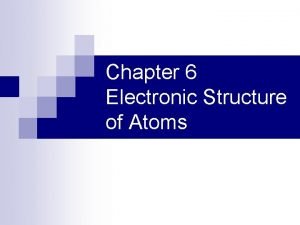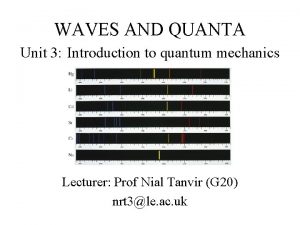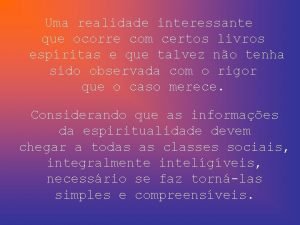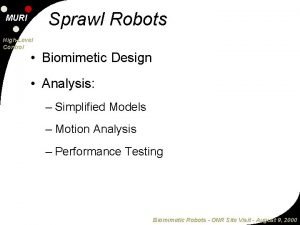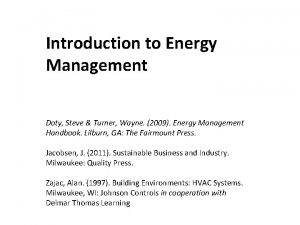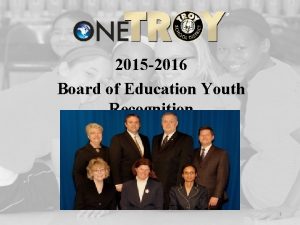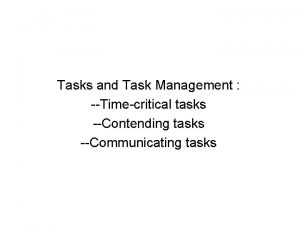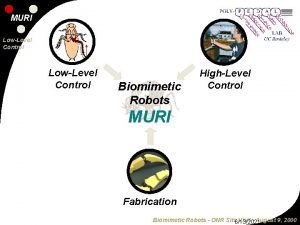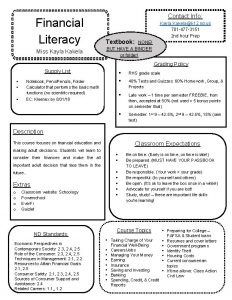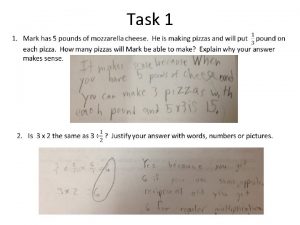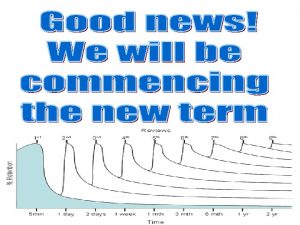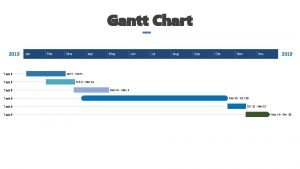Group Tasks Task Types MURI QUANTA Project Kayla
























- Slides: 24

Group Tasks & Task Types MURI QUANTA Project Kayla de la Haye Jen Labrecque September 16 2015

Groups & Group Tasks • Groups: ▫ a collection of individuals who are mutually aware of one another , their interdependence, and shared purpose/objective/goal • Group tasks: ▫ a task performed by a group (very broad) ▫ includes: instructions for acting on a ‘stimulus complex’ (physical/social/conceptual inputs) and goal directives (and potentially procedural directives) • Research Goal: ▫ understand the factors and processes that impact group performance on group tasks Larson, 2010

Models of Group Performance • The ‘population’ of groups and group tasks is large and varied • To meet our research goal, we want to develop models of group performance on group tasks that are: ▫ generalizable – they identify common factors that explain performance for many groups on many tasks ▫ have good predictive validity across contexts and task types ▫ identify important factors and processes Larson, 2010

Components of Group Performance • Performance effectiveness: how well groups perform on specific tasks ▫ Combined abilities and skills of group members ▫ Group interaction/behavior: the collaborative activities of the group done to accomplish the task • Performance integrity: the ability of the group to perform over time ▫ The effectiveness of the group over time: if this is maintained, increases, or declines Larson, 2010

Components of Group Tasks • Q: Why think about task components and task types? ▫ Different tasks place different demands on a group �This can have important effects on group processes and group performance �Task type can explain substantial variability in group performance (maybe 50%, Larson, 2010) • Ideally, our models of group performance can ▫ predict performance consistencies (e. g. , ‘collective intelligence’) ▫ and provide parsimonious and useful explanations of performance variability due to task types

Taxonomies of Group Tasks • Starting point: a comprehensive population of group tasks • Goal of group task taxonomies is to identify: ▫ underlying properties/dimensions of tasks and their relationships to one another ▫ meaningful similarities and differences across tasks ▫ important task dimensions that significantly impact group processes / effectiveness, and so explain performance variability • Value of taxonomies: ▫ informing generalizability: results apply to similar types of tasks ▫ theory building: identify factors that explain performance on related tasks and the underlying mechanisms Larson, 2010

Task Domains: Key Concepts • Idea-generation tasks: ▫ tasks that require novel and creative ideas • Problem-solving tasks: ▫ tasks with an objectively correct answer • Judgment tasks: ▫ tasks with a very difficult (if not impossible to determine) objectively correct answer • Decision-making tasks: ▫ tasks where the best answer may be difficult to determine, and which typically call for a choice (identifying the best choice) among a set of discrete alternatives Larson, 2010

Shaw’s Multi-dimensional Analysis of Task Structure • Early, quantitative approach to taxonomies • Factor analysis of attributes for over 104 varied group tasks • Identified 6 underlying task dimensions 1) 2) 3) 4) 5) 6) Task difficulty Solution multiplicity Cooperation requirements Intellectual-manipulative requirements Population familiarity Intrinsic interest Shaw, 1963

Laughlin’s Intellective-Judgmental Continuum Intellective Correct Solutions Judgmental No objectively correct solution • Focus on differences in problem-solving tasks based on one key dimension • Intellective tasks: ▫ with demonstrable solutions: the answer is obvious once proposed �just one person needs to find the solution for group to adopt it ▫ without demonstrable solutions: the correct answer is not easily identifiable to nonsolvers �requires more group members/complex group processes for the group to adopt it • Judgmental tasks: ▫ not demonstrable: group must establish what they believe is correct �dependent on group processes (e. g. , majority decisions, leaders) Laughlin, 1980/1986

Mc. Grath’s Group Task Circumplex Model

Mc. Grath’s Group Task Circumplex Model Basic organization: • 8 task types, mutually exclusive & exhaustive • Task types are related according to underlying 2 dimensional structure: ▫ Horizontal axis: Mental / conceptual vs physical / behavioral ▫ Vertical axis: Conflict vs cooperation within group • 4 quadrants specifying the required performance processes, each w/ 2 task types Mc. Grath, 1984

Mc. Grath’s Group Task Circumplex Model Quadrant I. Generate • Something is created or produced cooperation Task types differentiated by action-orientation I. Planning tasks – generate action-oriented plans / how to achieve the goal Ex/ Specify the sequence of steps that must be followed to successfully organize and run a charity dance marathon II. Creativity tasks – generate ideas that don’t have a strong action orientation Ex/ Brainstorming ideas for how to spend $10, 000

Mc. Grath’s Group Task Circumplex Model Quadrant II. Choose • Select a choice (from alternatives) conceptual Task types differentiated by whethere is an objectively correct answer: III. Intellective tasks – have an objectively correct answer Ex/ exam question IV. Decision-making tasks – no objectively correct answer, group decides what they think is correct Ex/ jury decisions

Mc. Grath’s Group Task Circumplex Model conflict Quadrant III. Negotiate • Group has to resolve conflict stemming from within Task types differentiated by source of conflict: V. Cognitive conflict tasks – must resolve differences in viewpoint Ex/ Team members interpret data differently, so can’t agree on what recommendation to give to policy makers VI. Mixed motive tasks – must resolve conflicts of interest Ex/ Social dilemma games in which one’s self-interest is at odds with the group’s interest

Mc. Grath’s Group Task Circumplex Model Quadrant IV. Execute • Usually requires physical action behavioral Tasks differentiated by competition against an adversary (or not) VII. Contests / battles / competitive tasks – performed against an opponent (win/lose) Ex/ basketball game, military battle VIII. Performances / psycho-motor tasks – striving to meet a standard of excellence Ex/ construction crew completes building project on time, to code, and within budget

Mc. Grath’s Group Task Circumplex Model Strengths Model Weaknesses Comprehensive, conceptual typology Possible overlapping task types / ambiguous classification (esp task types 4, 5, & 6) Appealingly simple structure / symmetry Clusters task together that have been shown to have different characteristics important to group outcomes (e. g. , All tasks w/ an objectively correct answer are categorized as Type 3, though they vary in demonstrability)

Steiner’s Group Task Typology (1) Divisible vs. Unitary Tasks • Divisible tasks can be separated into distinct parts that require different skills/abilities ▫ Subtask-person assignment is critical ▫ Subtasks may be completed fairly independently by group members, requiring minimal group processes ▫ Although there may some subtask interdependence (e. g. , sequential) • Unitary tasks cannot be meaningfully separated into distinct activities ▫ Process requires all members engage in the same activity, applying the same skills/abilities ▫ Likely to require more complex group behaviors and processes Steiner, 1966/1972

Steiner’s Group Task Typology (2) Maximizing vs. Optimizing Tasks • Differences in the nature of the task goals • Maximizing tasks: where the goal is to perform as much or as quickly as possible �E. g. , come up with as many items/solutions as possible ▫ Can be unitary or divisible • Optimizing tasks: where the goal is the production of a specific, desirable product �E. g. , come up with one, best solution ▫ Can be unitary or divisible Steiner, 1966/1972

Steiner’s Group Task Typology (3) Permitted Group Processes • Differences in the combinatorial processes permitted in unitary tasks: the ways that members efforts are combined to solve the task ▫ Additive tasks: group product is the sum of all members’ efforts, where contributions are weighted equally �E. g. : total # of ideas generated by the group ▫ Conjunctive tasks: require all group members to contribute identically, member contributions are constrained to be equal �E. g. , weakest link determines group performance ▫ Disjunctive tasks: permit just one member’s contributions to determine the group product, where an individual product is sanctioned by the group �E. g. , many problem solving tasks ▫ Discretionary tasks: no restraints on how member contributions are combined, up to the group �E. g. , optimizing tasks, like forecasting a future event

Steiner’s Group Task Typology Value of the model… • Useful for identifying group processes that contribute to group task performance, and why performance may differ across task types ▫ Different potential for group abilities, effectiveness, interactions/ behaviors to impact task outcome �Tasks may constrain the contribution of group members �Tasks provide different opportunities for group processes and emergent gains/losses in performance • Insight into individual vs. group performance ▫ why groups perform at the level of their average member vs. best member vs. better than their best member Steiner, 1966/1972

Summary of Task Typologies and Domains • Various approaches for identifying important task domains ▫ Mainly conceptual ▫ Few data-driven approaches • Overall reflect different opportunities/ constraints for group member abilities and group interaction/behavior to impact group performance

Collective Intelligence • Using tasks from all quadrants of the Mc. Grath Task Circumplex, Woolley et al. (2010) found evidence for a general collective intelligence factor c: 1) positive correlation among scores on different tasks (r =. 28) 2) initial factor accounting for > 43% of the variance 3) c more strongly related to performance on complex (criterion) tasks than group performance on simpler/pure tasks • Understanding underlying latent variable that explains consistency on performance across task types ▫ Rather than factors that explain differences on task dimensions/domains Woolley, 2010; Malone

Collective Performance Differences • Ideally, our models of group performance can ▫ predict performance consistencies (e. g. , ‘collective intelligence’) ▫ and provide parsimonious and useful explanations of performance variability due to task types � 50% of variance may be explained by task types (Larson, 2010) • Task typologies: useful framework for developing models that identify group factors and processes that explain predictable performance variability

Overall Summary • The extent to which different factors - group member characteristics, group characteristics, emergent group processes/behaviors –contribute to and impact performance is, to some extent, dependent on the requirements of the task ▫ And so we need to understand key similarities and differences in task types: task typologies are a useful framework • Assessing group performance ▫ On isolated “pure” task domains �valuable for understanding factors that impact specific task domains �but maybe not generalizable ▫ Using batteries of varied tasks (or complex multi-domain tasks) �valuable for understanding factors that predict performance stability and variability, and identifying underlying processes �maybe loose some specificity �computing ‘c’ , a latent ‘collective intelligence’ factor, may have incremental predictive validity (worth exploring further…)
 Roberto carlos quando eu quero falar com deus
Roberto carlos quando eu quero falar com deus Quando eu quero falar com deus eu apenas falo
Quando eu quero falar com deus eu apenas falo Vede senhor
Vede senhor Inquinamento plastica
Inquinamento plastica Chem
Chem Energy quanta
Energy quanta Quanta unit
Quanta unit Quanta paz
Quanta paz Esclamativo
Esclamativo Quanta namera
Quanta namera Eminescu oda in metru antic
Eminescu oda in metru antic Juri muri po sloveniji
Juri muri po sloveniji Qeliza prokariote
Qeliza prokariote Muri thigs
Muri thigs Sporulima
Sporulima Kayla oxley
Kayla oxley Genetically modified crops
Genetically modified crops Cloud 9 kayla morgan
Cloud 9 kayla morgan Kayla tomlin
Kayla tomlin Where is taiga located on the map
Where is taiga located on the map Kayla adair
Kayla adair Ohsu health services referral and authorization form
Ohsu health services referral and authorization form M.u.g. #12 answers
M.u.g. #12 answers Kayla turner periodista
Kayla turner periodista Sukhnayak sohi
Sukhnayak sohi





